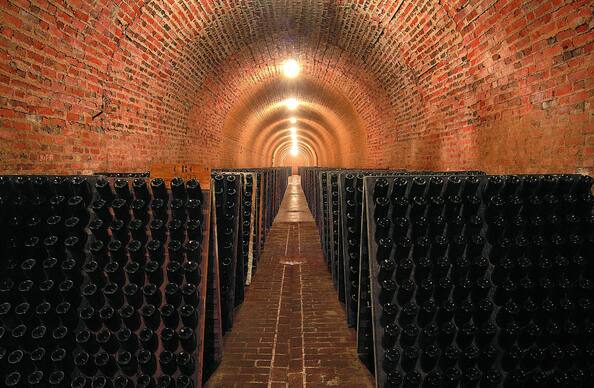Viñedos, casas y bodegas de Champaña
Champagne Hillsides, Houses and Cellars
The property encompasses sites where the method of producing sparkling wines was developed on the principle of secondary fermentation in the bottle since the early 17th century to its early industrialization in the 19th century. The property is made up of three distinct ensembles: the historic vineyards of Hautvillers, Aÿ and Mareuil-sur-Aÿ, Saint-Nicaise Hill in Reims, and the Avenue de Champagne and Fort Chabrol in Epernay. These three components – the supply basin formed by the historic hillsides, the production sites (with their underground cellars) and the sales and distribution centres (the Champagne Houses) - illustrate the entire champagne production process. The property bears clear testimony to the development of a very specialized artisan activity that has become an agro-industrial enterprise.
La description est disponible sous licence CC-BY-SA IGO 3.0
Coteaux, Maisons et Caves de Champagne
Il s’agit des lieux où fut développée la méthode d’élaboration des vins effervescents, grâce à la seconde fermentation en bouteille, depuis ses débuts au XVIIe siècle jusqu'à son industrialisation précoce au XIXe siècle. Le bien se compose de trois ensembles distincts : les vignobles historiques d’Hautvillers, Aÿ et Mareuil-sur-Aÿ, la colline Saint-Nicaise à Reims et l’avenue de Champagne et le Fort Chabrol à Epernay. Ces trois ensembles –soit le bassin d’approvisionnement que forment les coteaux historiques, les unités de production (les caves souterraines) et les espaces de commercialisation (les maisons de Champagne)- reflètent la totalité du processus de production de champagne. Le bien illustre clairement comment cette production a évolué d’une activité artisanale très spécialisée à une entreprise agro-industrielle.
La description est disponible sous licence CC-BY-SA IGO 3.0
مناطق زراعة الكروم في بورغندي
هي عبارة عن قطع صغيرة من الأراضي المحددة المساحة لزراعة الكروم تقع على منحدرات "كوت دي نوي" و"كوت دي بون" جنوب مدينة "ديجون". وتختلف هذه المناطق بعضها عن بعض بسبب ظروف طبيعية معينة (الجيولوجيا، والتعرض للأحوال المناخية)، فضلاً عن أنواع النبيذ المنتجة هناك، علماً بأنها تشكلت بفعل الأنشطة التي يقوم بها المزارعون. وبمرور الزمن، اشتهرت هذه المناطق بفضل أنواع النبيذ الذي يتم انتاجها فيها. ويتألف هذا المشهد الثقافي من جزأين: أولهما مزارع الكروم ووحدات الإنتاج الملحقة بها، بما في ذلك القرى ومدينة "بون" التي تمثل البعد التجاري لنظام الإنتاج. أما الجزء الثاني فهو يشمل وسط مدينة "ديجون" التاريخي الذي يجسد الزخم السياسي والقانوني الذي أسفر عن إنشاء نظام هذه المناطق. ويُعتبر الموقع مثالاً بارزاً لإنتاج الكروم والنبيذ الذي تطور منذ العصور الوسطى.
source: UNESCO/CPE
La description est disponible sous licence CC-BY-SA IGO 3.0
香槟地区山坡、房屋和酒窖
source: UNESCO/CPE
La description est disponible sous licence CC-BY-SA IGO 3.0
Склоны холмов, винодельческие дома и погреба Шампани
Объект включает в себя места, где была разработана технология производства игристых вин методом вторичного брожения в бутылке. Этот метод был открыт в XVII веке и уже в XIX веке использовался в широких масштабах. Объект состоит из трех элементов: исторические виноградники в коммунах Отвильер, Аи и Марёй-сюр-Аи, холм Сен-Никез в городе Реймс, а также авеню де Шампань и Форт Шаброль в городе Эперне. Склоны холмов, уже несколько столетий используемые для выращивания винограда, подземные погреба, где вино выдерживается, и винодельческие дома, занимающиеся его торговлей, составляют цепочку процесса изготовления и коммерческий реализации шампанского. Объект позволяет получить ясное представление о том, как производство шампанского постепенно приобретало размах, превращаясь из ремесла, навыками которого владела лишь небольшая группа мелких производителей, в целую агропромышленную отрасль.
source: UNESCO/CPE
La description est disponible sous licence CC-BY-SA IGO 3.0
Viñedos, casas y bodegas de Champaña
Este bien cultural comprende una serie de lugares en los que se elaboró el método de producción de vinos espumosos mediante una segunda fermentación en botella, iniciada en el siglo XVII y aplicada precozmente a escala industrial desde el siglo XIX. El sitio comprende tres conjuntos distintos: los viñedos históricos de Hautvilliers, Aÿ y Mareuil-sur-Aÿ; la colina de Santa Nicasia en la ciudad de Reims; y la avenida de Champaña y el instituto de enología “Fort Chabrol”, en la ciudad de Epernay. Las zonas de viñedos, junto con las bodegas subterráneas donde fermenta el champaña y las sedes de las empresas que lo comercializan, representan la totalidad de las fases de producción de este renombrado caldo. El sitio es ilustrativo de la evolución experimentada por la producción del champaña, elaborado antaño por artesanos sumamente especializados y fabricado hoy en día por importantes empresas agroindustriales.
source: UNESCO/CPE
La description est disponible sous licence CC-BY-SA IGO 3.0
シャンパーニュの丘陵、メゾンとカーヴ
フランス北東部のシャンパーニュ地方は、ボトルの中で二次発酵させるスパークリングワインの生産方法が開発・確立された土地。ここでは葡萄畑、地下貯蔵庫や家屋などワインの生産や流通機能を持った村や市街地が、独特な農工業景観を形成している。景観のみならず、地域経済と日常生活を形成してきた農工業システムも重要で、これらは数世代にわたって完成された技術や職人組織、原産地証明の保護など、技術的・社会的革新の発展によってもたらされた成果である。source: NFUAJ
Heuvels, huizen en kelders van de Champagne
Dit werelderfgoed omvat locaties waar de methode van het produceren van mousserende wijnen werd ontwikkeld, gebaseerd op het principe van nagisting op de fles, sinds het begin van de 17e eeuw tot de vroege industrialisering in de 19e eeuw. Het erfgoed bestaat uit drie verschillende ensembles: de historische wijngaarden van Hautvilliers, Aÿ en Mareuil-sur-Aÿ, de heuvel van Saint-Nicaise in Reims, en de Avenue de Champagne en Fort Chabrol in Epernay. Deze drie componenten – het leveringsgebied op de historische heuvels, de productielocaties (met hun ondergrondse kelders) en de verkoop- en distributiecentra (de Champagne Huizen) – illustreren het volledige champagneproductieproces. Dit erfgoed getuigt van de ontwikkeling van een zeer gespecialiseerde ambachtelijke activiteit naar een vorm van agro-industrie.
Source : unesco.nl
